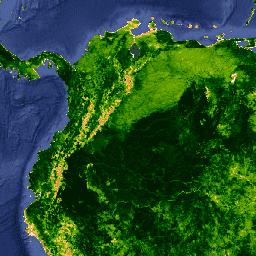Page Summary
-
This dataset, which provides global MODIS vegetation indices, is superseded by MODIS/061/MOD13A1.
-
It offers consistent spatial and temporal comparisons of vegetation conditions using blue, red, and near-infrared reflectances.
-
The dataset includes both the Normalized Difference Vegetation Index (NDVI) and a new Enhanced Vegetation Index (EVI).
-
Global MOD13A1 data is available every 16 days at 500-meter spatial resolution and is used for global monitoring of vegetation and input for modeling.
-
This version of MODIS Vegetation Indices products has attained Validation Stage 3 and has no restrictions on subsequent use.

- Dataset Availability
- 2000-02-18T00:00:00Z–2017-03-06T00:00:00Z
- Dataset Provider
- NASA LP DAAC at the USGS EROS Center
- Cadence
- 16 Days
- Tags
Description
Global MODIS vegetation indices are designed to provide consistent spatial and temporal comparisons of vegetation conditions. Blue, red, and near-infrared reflectances, centered at 469-nanometers, 645-nanometers, and 858-nanometers, respectively, are used to determine the MODIS daily vegetation indices.
The MODIS Normalized Difference Vegetation Index (NDVI) complements NOAA's Advanced Very High Resolution Radiometer (AVHRR) NDVI products provide continuity for time series historical applications. MODIS also includes a new Enhanced Vegetation Index (EVI) that minimizes canopy background variations and maintains sensitivity over dense vegetation conditions. The EVI also uses the blue band to remove residual atmosphere contamination caused by smoke and sub-pixel thin cloud clouds. The MODIS NDVI and EVI products are computed from atmospherically corrected bi-directional surface reflectances that have been masked for water, clouds, heavy aerosols, and cloud shadows.
Global MOD13A1 data are provided every 16 days at 500-meter spatial resolution as a gridded level-3 product in the Sinusoidal projection. Vegetation indices are used for global monitoring of vegetation conditions and are used in products displaying land cover and land cover changes. These data may be used as input for modeling global biogeochemical and hydrologic processes and global and regional climate. These data also may be used for characterizing land surface biophysical properties and processes, including primary production and land cover conversion.
Version-5 MODIS Vegetation Indices products have attained Validation Stage 3.
Please visit LP DAAC 'Citing Our Data' page for information on citing LP DAAC datasets.
Bands
Bands
| Name | Pixel Size | Description |
|---|
Terms of Use
Terms of Use
MODIS data and products acquired through the LP DAAC have no restrictions on subsequent use, sale, or redistribution.
Explore with Earth Engine
Code Editor (JavaScript)
var dataset = ee.ImageCollection('MODIS/MOD13A1') .filter(ee.Filter.date('2014-04-01', '2014-06-01')); var ndvi = dataset.select('NDVI'); var ndviVis = { palette: [ 'ffffff', 'ce7e45', 'df923d', 'f1b555', 'fcd163', '99b718', '74a901', '66a000', '529400', '3e8601', '207401', '056201', '004c00', '023b01', '012e01', '011d01', '011301' ], }; Map.setCenter(-7.03, 31.05, 2); Map.addLayer(ndvi, ndviVis, 'NDVI');